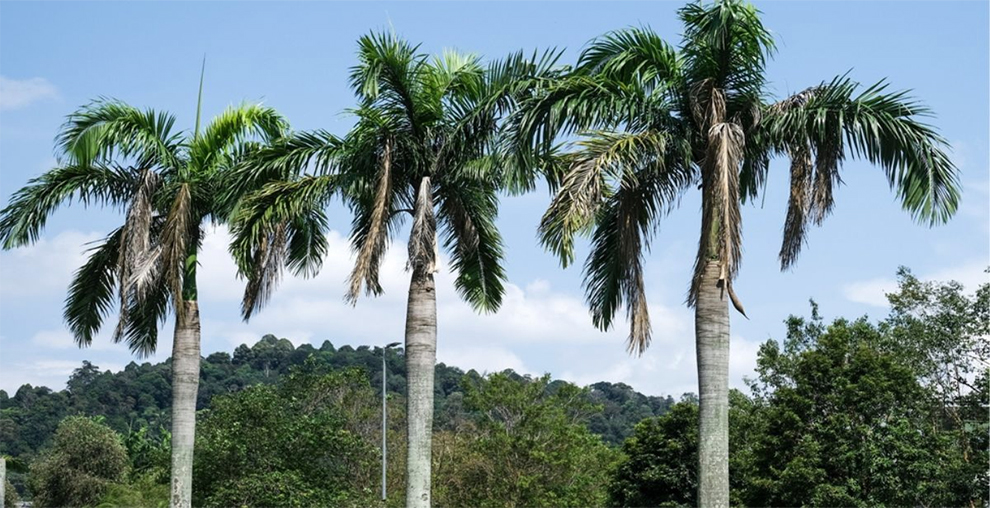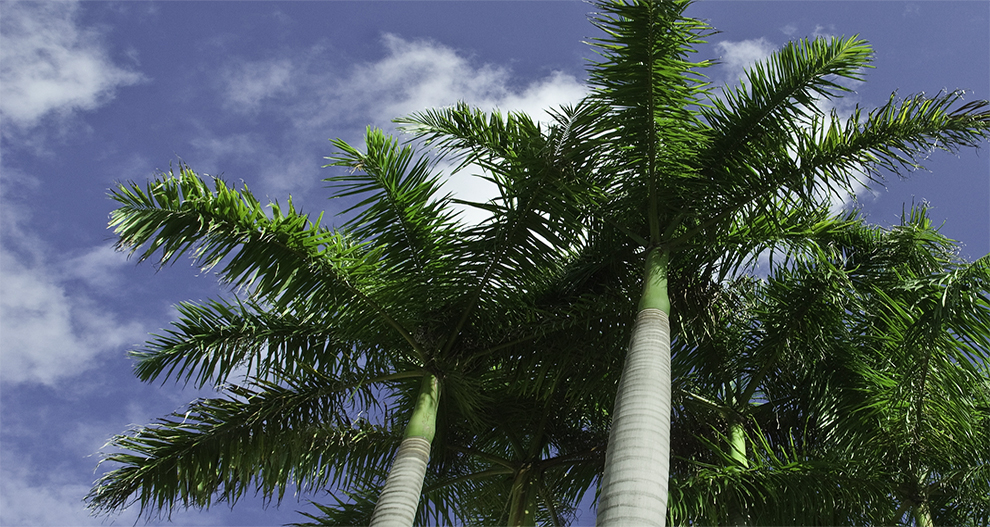Royal Palm Growth Rate | Fast or Slow?
The growth rate of royal palm tree is relatively slow to moderate. They add 1-2 feet every year as their annual growth.

The Royal Palm often referred to as the aristocrat of palm trees due to its regal appearance and elegance is undoubtedly a majestic addition to any landscape.
With its tall and slender trunk, topped with a crown of feathery fronds, this palm tree exudes a sense of tropical luxury and sophistication. As one of the most popular types of palm trees in the world, many people are drawn to the royal palm for its striking appearance and versatility in a variety of settings.
But they do take time to fully grow and develop this beautiful appearance. So, today we’ll tell you how fast do royal palm trees grow.
You must know that they have a slow to moderate growth rate, so if beautification of an area is the idea behind planting a palm, it is best to opt for a live plant from the nursery rather than planting it from seeds.
The growth rate of royal palms can vary depending on several factors, including the species, the climate, the soil conditions, and the amount of care they receive.
On average, royal palms grow at a slow to moderate rate of about 1 to 2 feet per year. Its slow to moderate growth rate allows it to establish a strong root system and sturdy trunk, making it resistant to strong winds and other environmental stressors.
While this may not be the fastest growth rate among palm trees, royal palms are still highly valued for their graceful appearance, durability, and adaptability to a wide range of growing conditions.
Whether you’re looking to plant a single royal palm in your backyard or create a stunning tropical landscape, understanding the growth rate of this iconic tree is an important part of successful palm tree cultivation.
In this guide, we’ll explore the factors that influence the royal palm growth rate, as well as tips for optimizing their growth and achieving the perfect look for your landscape.
Royal Palm Tree Information
| Scientific name | Roystonea oleracea |
| Height | Up to 50 – 70 ft tall |
| Width | 10 -15 feet in diameter |
| Flower | Fragrant flowers are typically white, cream, or yellow, and are arranged in large, showy clusters that can reach up to 5 feet (1.5 meters) in length. The flowers emerge from a long stalk that extends beyond the crown of fronds, adding to the tree’s striking appearance. |
| Growing conditions | · Royal palm trees prefer warm, tropical climates and are typically grown in USDA hardiness zones 10-11. They prefer full sunlight and should be planted in a location with at least 6 hours of direct sunlight per day. They can tolerate some shade but will not grow as quickly or vigorously.
· Well-draining and fertile soil that is rich in organic matter is ideal for their growth. Though they can tolerate a range of soil types, including sand, loam, and clay, as long as the soil is not too heavy or compacted. · Royal palm trees require regular watering, particularly during the first few years of growth. They prefer moist, but not waterlogged soil, and should be watered deeply once or twice per week, depending on rainfall and humidity levels. · These palms benefit from regular fertilization, particularly during the growing season. A balanced, slow-release fertilizer can help to promote healthy growth and vibrant foliage. |
| How fast do royal palms grow per year? | · The slow-moderate growth rate of around 1 to 2 feet each year |
Do Royal Palms Grow Fast?

Royal palms are known to be slow to moderate growers so they are not very fast.
While they may not be the fastest-growing palms, they are highly prized for their elegant appearance and tropical beauty and are often used in landscaping to add a touch of the exotic to gardens, parks, and public spaces.
There are several other palm species that are known for their fast growth, including:
- Queen Palm (Syagrus romanzoffiana)
- Mexican Fan Palm (Washingtonia robusta)
- Canary Island Date Palm (Phoenix canariensis)
- Windmill Palm (Trachycarpus fortunei)
- Christmas Palm (Veitchia merrillii)
These palms are known to be relatively fast-growing and can grow up to several feet per year under ideal conditions. However, it’s important to note that growth rates can vary depending on the species, the climate, the soil conditions, and other factors.
While faster growth may be desirable in some cases, it’s important to choose the right palm tree for your specific needs and growing conditions, taking into account factors such as size, appearance, hardiness, and maintenance requirements.
How Fast Does A Royal Palm Tree Grow In A Year?

Royal palm trees typically grow at a slow to moderate growth rate of around 1-2 feet per year, although the growth rate can vary depending on environmental conditions and palm care.
In ideal conditions, with plenty of sunlight, regular watering, and fertilization, a royal palm tree may grow slightly faster, up to 2 to 3 feet per year.
Two Types Of Royal Palm and Their Growth Rate
Royal palm trees are a group of tall, elegant, and stately palm trees known for their striking appearance and tropical beauty. They belong to the genus Roystonea and are native to the Caribbean, South America, and parts of Central America.
There are two different species of the royal palm tree – Roystonea regia, also known as Cuban royal palm, and Roystonea elata, known as the Florida royal palm.
Both species of royal palm tree are popular ornamental trees, prized for their elegant appearance and tropical beauty.
A. Cuban Royal Palm

The Cuban Royal Palm, also known as Roystonea regia, is a tall and graceful palm tree native to Florida, the Caribbean, and parts of Central and South America. This royal palm tree growth rate is also the same i.e., 1-2 feet per year.
They grow up to 50 to 70 feet (15 to 21 meters) tall, with a trunk that is smooth, straight, and slightly bulging at the base. The fronds of the Cuban Royal Palm are large, bright green, and feathery, growing up to 10 to 15 feet (3 to 4.5 meters) in length.
The tree produces white, fragrant flowers that attract bees and other pollinators, which later develop into small black berries.
The Cuban Royal Palm is a popular ornamental tree, prized for its striking appearance, and is often used in landscaping to add a tropical and exotic touch to gardens, parks, and public spaces.
B. Florida royal palm

Florida royal palm or Roystonea elata is a species of palm tree that is native to Cuba, the Dominican Republic, and Haiti. It is also known as the “Florida Tall Royal Palm” or simply the “Tall Royal Palm.”
This variety can grow up to 1-2 feet per year as well. It is a tall, slender tree that can grow up to 100 feet (30 meters) tall with a trunk that is smooth, straight, and gray in color. The crown shaft is swollen at the base and is green in color.
The fronds are large and feathery, growing up to 10 to 15 feet (3 to 4.5 meters) long. Roystonea elata produces clusters of small, white flowers that develop into small, reddish berries.
Related Growth Rates: European fan palm | Foxtail palm | Sago palm | Pygmy palm | Ponytail palm | Areca palm | Parlor palm
How To Make The Royal Palm Grow Faster?
Several factors can influence the growth rate of a royal palm tree, and providing the right conditions and care can help promote faster growth. Here are some tips to help your royal palm tree grow faster:
- Plant in a sunny location: Royal palm trees require plenty of sunlight to grow, so make sure to plant them in a location that receives at least 6 hours of direct sunlight each day.
- Provide regular watering: Royal palm trees need regular watering, especially during the hot and dry seasons. Make sure to water deeply, but do not overwater, as this can cause root rot.
- Fertilize regularly: Royal palm trees benefit from regular fertilization, especially with a balanced fertilizer containing nitrogen, phosphorus, and potassium. Apply fertilizer every 3 to 4 months during the growing season.
- Prune as needed: Pruning can help promote faster growth by removing dead or damaged palm fronds and promoting the growth of new ones.
- Control pests and diseases: Pests and diseases can slow down the growth of royal palm trees. Regularly monitor your tree for signs of pests or diseases and treat them promptly to prevent them from causing damage.
- Mulch around the base of the tree: Mulching can help retain moisture and nutrients around the base of the tree, promoting faster growth.
With Moderate Growth How Big Does A Royal Palm Get?
Space the palm trees appropriately because they grow big. Royal palm trees can grow to be quite large, reaching heights of 50 to 70 feet tall, and with a spread of up to 15 feet (7.6 meters) wide.
The royal palm tree growth rate can vary depending on environmental conditions and depending on that it matures to achieve a full height in a specific amount of time.
When young, royal palm trees have a single, smooth trunk, but as they mature, the trunk develops a distinctive bulge at the base, which is called a “crown shaft.” The crown shaft is a characteristic feature of the royal palm tree and can add another 10 to 20 feet (3 to 6 meters) to its overall height.
What Is The Lifespan Of A Royal Palm Tree?
The lifespan of a royal palm tree can vary depending on several factors, including environmental conditions, care, and disease. In general, a healthy royal palm tree can live for up to 100 years or more.
However, the lifespan of a palm tree can be significantly shortened if it is affected by pests or diseases, such as Fusarium wilt or lethal yellowing disease. These diseases can cause the tree to die within a few years.
